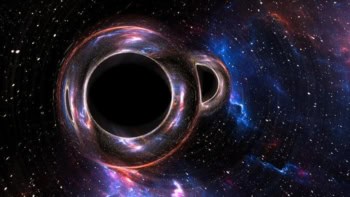
The 2015 Nobel Prize for Physics has been awarded to Arthur B McDonald and Takaaki Kajita “for the discovery of neutrino oscillations, which shows that neutrinos have mass”.
The prize is worth SEK 8m (£629,000) and will be shared by the two winners who will receive their medals at a ceremony in Stockholm on 10 December.
Kajita is a Japanese citizen and a member of the Super-Kamiokande collaboration. He is professor of physics at the University of Tokyo. McDonald is a Canadian citizen and director of the Sudbury Neutrino Observatory (SNO). He is emeritus professor of physics at Queen’s University.
Eureka moment
Speaking on the telephone from Canada after the announcement, McDonald said that “There was a eureka moment when we were able to see that neutrinos appeared to change from one type to the other in travelling from the Sun to the Earth.” He added that he is very pleased to have “many colleagues that share this prize with me”. “It is a tremendous accolade for our group,” he said. McDonald also said that he has a very good relationship with Kajita and his Super-Kamiokande colleagues.
Neutrinos are particles with no electrical charge that interact very weakly with matter – making them extremely difficult to detect. Their existence was first predicted in 1930 by Wolfgang Pauli as a “desperate remedy” for discrepancies arising in the study of beta decays. At the time Pauli was convinced that neutrinos would be impossible to detect but he was happily proved wrong in 1956 when Frederick Reines and Clyde Cowan detected antineutrinos emitted by a nuclear reactor, for which the pair went on to win the 1995 Nobel Prize for Physics.
In 1957 Italian physicist Bruno Pontecorvo suggested that multiple types, or “flavours”, of neutrinos exist and that they can change, or “oscillate”, from one to another. Multiple neutrino flavours were confirmed in 1962 when Leon Lederman, Melvin Schwartz and Jack Steinberger at Brookhaven National Laboratory in the US observed the existence of both Pauli’s electron neutrino and also the muon neutrino. A third type of neutrino – the tau – was predicted in 1975 and discovered in 2000.
The concept of neutrino oscillation came to the fore in 1964, when Raymond Davis and John Bahcall found that their solar-neutrino experiment in the Homestake Gold Mine in South Dakota detected only about 30% of the electron neutrinos predicted by a theory developed by Bahcall. This discrepancy could only be explained if neutrinos were oscillating between flavours as they travel from the Sun to the Earth. If oscillation was occurring, then it meant that neutrinos have mass, contrary to what the Standard Model of particle physics predicted.
Ends of the Earth
In 1998 Kajita presented data taken by the Super-Kamiokande experiment that showed that the ratio of electron to muon neutrinos coming from opposite sides of the Earth were different. This meant that these neutrinos – created when cosmic rays interact with nuclei in the upper atmosphere – were changing flavour as they passed through the Earth. This showed for the first time that neutrinos must have mass, albeit only about 0.1 eV.
Then, in 2001 and 2002 McDonald and his colleagues at SNO reported how many of the electron neutrinos produced in the Sun change into muon neutrinos or tau neutrinos as they travel to the Earth. This was possible because SNO could measure the number of neutrinos of all flavours arriving from the Sun as well as the number of electron neutrinos arriving from the Sun. These measurements allowed McDonald and colleagues to both confirm Bahcall’s theoretical prediction of the solar electron neutrino flux and also show that about two-thirds of the solar electron neutrinos change flavour by the time they reach the Earth.
The evidence for neutrino oscillations was further strengthened earlier this year when researchers at the T2K (Tokai to Kamioka) experiment in Japan fired a beam of muon neutrinos 295 km through the ground to Super-Kamiokande. There they detected electron neutrinos with a statistical significance greater than 5σ, confirming that muon neutrinos do indeed oscillate into electron neutrinos.
The discoveries are also triumphs of experimental physics because neutrinos have no electrical charge and interact very rarely with matter. As a result they are extremely difficult to detect. This is why both Super-Kamiokande and SNO are located deep underground, to shield them from cosmic radiation.
Earlier this year, McDonald explained to Physics World why such experiments are built underground:
McDonald was born in 1943 in Sydney, Nova Scotia and did a BSc and an MSc in physics at Dalhousie University in Halifax. He then moved to the US, where he completed a PhD at Caltech in 1969 before returning to Canada to work at Atomic Energy of Canada’s Chalk River Laboratories until 1982. After a seven-year stint at Princeton University, he joined Queen’s University in Kingston, Ontario in 1989, when he also became director of SNO.
Nick Jelley of the University of Oxford, who worked on SNO, describes McDonald as “a great person to work with and a great leader”. He told Physics World that McDonald made SNO possible because he was able to convince a senior executive at the Canadian mining company Inco to allow physicists to build the laboratory in a working nickel mine.
Kajita was born in 1959 in Higashimatsuyama, Saitama Prefecture and completed a BSc in physics at Saitama University in 1981. He then pursued MS and PhD degrees at the University of Tokyo, completing his studies in 1986. Two years later Kajita joined the Institute for Cosmic Ray Research at the University of Tokyo, where he is currently director.



